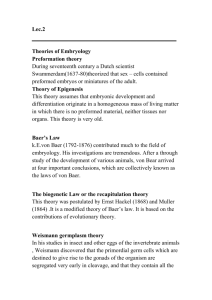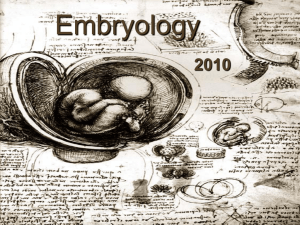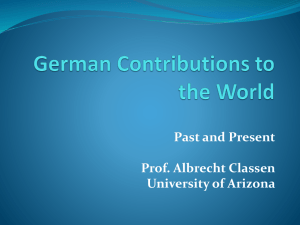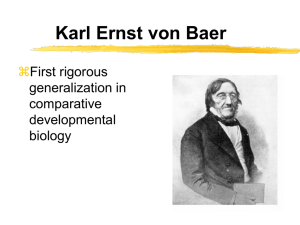Karl Ernst von Baer
advertisement
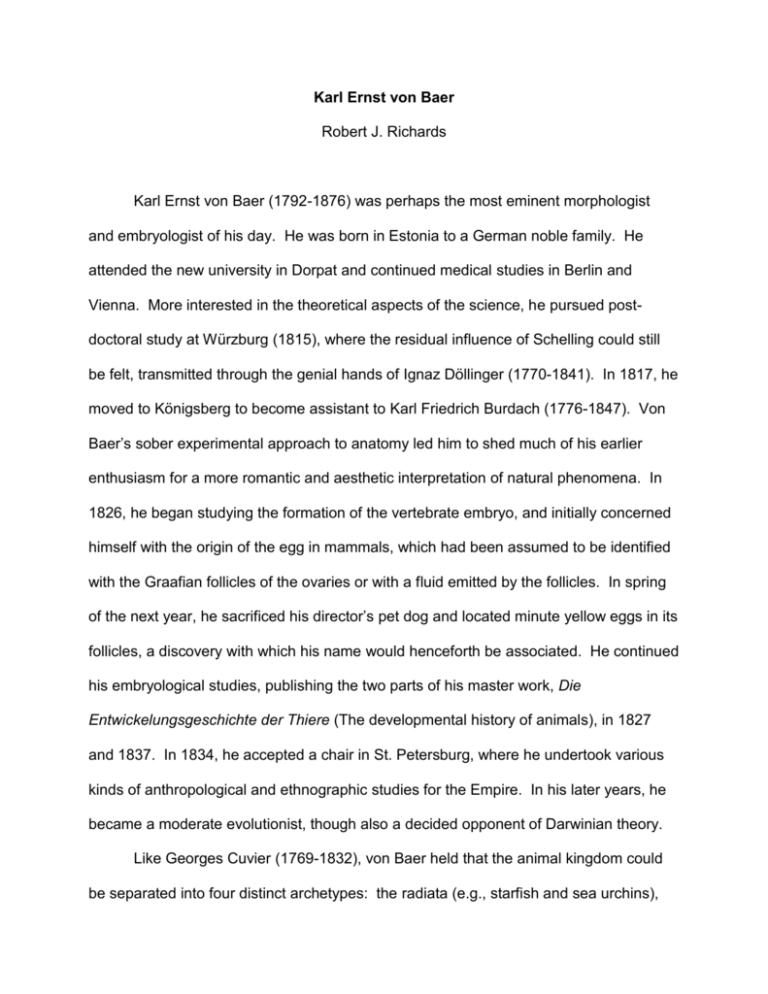
Karl Ernst von Baer Robert J. Richards Karl Ernst von Baer (1792-1876) was perhaps the most eminent morphologist and embryologist of his day. He was born in Estonia to a German noble family. He attended the new university in Dorpat and continued medical studies in Berlin and Vienna. More interested in the theoretical aspects of the science, he pursued postdoctoral study at Würzburg (1815), where the residual influence of Schelling could still be felt, transmitted through the genial hands of Ignaz Döllinger (1770-1841). In 1817, he moved to Königsberg to become assistant to Karl Friedrich Burdach (1776-1847). Von Baer’s sober experimental approach to anatomy led him to shed much of his earlier enthusiasm for a more romantic and aesthetic interpretation of natural phenomena. In 1826, he began studying the formation of the vertebrate embryo, and initially concerned himself with the origin of the egg in mammals, which had been assumed to be identified with the Graafian follicles of the ovaries or with a fluid emitted by the follicles. In spring of the next year, he sacrificed his director’s pet dog and located minute yellow eggs in its follicles, a discovery with which his name would henceforth be associated. He continued his embryological studies, publishing the two parts of his master work, Die Entwickelungsgeschichte der Thiere (The developmental history of animals), in 1827 and 1837. In 1834, he accepted a chair in St. Petersburg, where he undertook various kinds of anthropological and ethnographic studies for the Empire. In his later years, he became a moderate evolutionist, though also a decided opponent of Darwinian theory. Like Georges Cuvier (1769-1832), von Baer held that the animal kingdom could be separated into four distinct archetypes: the radiata (e.g., starfish and sea urchins), the mollusca (e.g., clams and octopus), the articulata (e.g., insects and crabs), and the vertebrata (e.g., fish and human beings). He denied recapitulation theory—the idea that the embryos of more complex animals passed through morphological stages comparable to those of the adult forms of organisms lower in the hierarchy of life. He maintained that the embryo of an animal exemplified from the beginning of its gestation only the archetype or Urform of that particular organism. “The embryo of the vertebrate,” he asserted, “is already at the beginning a vertebrate” (1828-1837, 1: 220). So a human fetus, he held, would move through stages in which it would take on the form of a generalized vertebrate, a generalized mammal, a generalized primate, and finally a particular human being. The form of the growing fetus moved from the general to the specific. The human embryo, in its early stages, therefore, never assumed the mature form of an invertebrate or of a fish. Despite von Baer’s rejection of strict recapitulation, he did allow that species within a given archetype yet displayed virtually identical structures during the earlier stages of embryogenesis. In a famous passage, which Darwin mistakenly attributed to Louis Agassiz (1807-1873), von Baer mentioned that he had two little embryos that he forgot to label: “They might be lizards, small birds, or very young mammals. The formation of the heads and trunks in these animals is quite similar. The extremities are not yet present in these embryos. But even if they were in the first stages of development, they would not indicate anything; since the feet of lizards and mammals, the wings and feet of birds, as well as the hands and feet of men develop from the same fundamental form” (1828-1837, 1: 221). Though he became wary of the Romantic Naturphilosophie exhibited by many 2 German morphologists, von Baer yet retained certain metaphysical ideas that connected him with the tradition of transcendental idealism that was inaugurated by Schelling. He seems never to have abandoned the conviction, for example, that the archetype of the organism, as a kind of extra-physical entity, guided the creature’s morphological development. “The type of every animal,” he declared, “both becomes fixed in the embryo at the beginning and governs its entire development” (1828-1837, 1: 220). Von Baer objected to the transmutational theory that was becoming quickly rooted in German biology. He understood that ideas of recapitulation and of species evolution gave seductive succor to one another—and he firmly opposed them both: One gradually learned to think of the different animal forms as developing out of one another—and then shortly to forget that this metamorphosis was only a mode of conception. Fortified by the fact that in the oldest layers of the earth no remains from vertebrates were to be found, naturalists believed they could prove that such unfolding of the different animal forms was historically grounded. They then related with complete seriousness and in detail how such forms arose from one another. Nothing was easier. A fish that swam upon the land wished to go for a walk, but could not use its fins. The fins shrunk in breath from want of exercise and grew in length. This went on through generations for a couple of centuries. So it is no wonder that out of fins feet have finally emerged (1828-1837, 1: 200). The community of German zoologists lived along several conceptual fissures. Some, like the redoubtable von Baer, rejected the notion of recapitulation and the supportive doctrine of species descent. Georg Heinrich Bronn (1800-1862), Darwin’s 3 first German translator, thought species progressively appeared on the earth over vast periods of time according to a Divine plan. He recognized that embryonic development bore strong analogy to the morphological development of species; but fearing, perhaps, the consequences of the recapitulational idea, he stressed the analogical character of the parallel and reaffirmed the boundaries of embryogenesis that von Baer had established. Others, like the Romantic Lorenz Oken 1779-1851) and the aesthetically driven Georg Gustav Carus (1789-1869), unhesitatingly advanced the theory of the archetype and its attendant notion of recapitulation, while the embryologists Friedrich Tiedemann (1781-1861) and Johann Friedrich Meckel (1781-1833), under the influence of Lamarck, accepted the doctrine of species transformation. Darwin adopted recapitulation theory, despite von Baer’s strictures. He agreed that the embryo passed from a generalized to a more particular morphological state. He simply held that the phylogenetic ancestor was of a general type—for instance, that the evolutionary progenitor of man was a generalized vertebrate whose form would be recapitulated in the human embryo. “Thus the embryo,” Darwin observed in the Origin of Species (p. 338), “comes to be left as a sort of picture, preserved by nature, of the ancient and less modified condition of each animal.” By the early 1870s, the evolutionary thesis had swept through Europe, leaving only the most recalcitrant in its wake. Von Baer understood that the kind of empirical evidence Darwin cited, especially from biogeography and paleontology, pointed only in one direction. Yet he would not countenance Darwin’s devices of species change— chance variation and natural selection, which could not account for the teleological structure of organisms. If Darwinism were correct, intermediate forms should be 4 produced by selection, but none were found. Chance variation, which the theory assumes, should fluctuate in both positive and negative directions, thwarting evolutionary advance. Moreover, selected traits would, through random mating, be swamped out. Von Baer rather supposed that the great classes of animals and plants appeared suddenly in ancient times, as the gap-ridden fossil record indicated, and that internal, teleological laws had to determine evolutionary transitions within each of the larger groups of animals—fish, reptiles, birds, mammals—all arching toward particular goals and diminishing in power as the present time was approached. Von Baer offered his specific hypothesis only tentatively but hoped he had awakened in the reader recognition that “for a true understanding of nature, we cannot dispense with a governing intelligence” (1876, 2: 473). Remembering his early work in embryology, evolutionists and anti-evolutionists alike revered the great Karl Ernst von Baer. 5 References Baer, K. E. von. 1828-1837. Entwickelungsgeschichte der Thiere: Beobachtung und Reflexion, 2 vols. Königsberg: Bornträger. ________. 1876. Ueber Darwins Lehre, in his Studien auf dem Gebiete der Naturwissenschaften, 2 vols. St. Petersberg: Schmitzdorff. 2: 235-480. ________. 1886 [1986]. Autobiography of Dr. Karl Ernst von Baer. 2nd ed. ed. J. Oppenheimer. Trans. H. Schneider. New York: Science History Publications. Darwin, C. 1859. On the Origin of Species. London: Murray. Oppenheimer, J. 1967. Essays in the History of Embryology and Biology. Cambridge: M.I.T. Press. Richards, R. 1992. The Meaning of Evolution: The Morphological Construction and Ideological Reconstruction of Darwin’s Theory. Chicago: University of Chicago Press. 6
